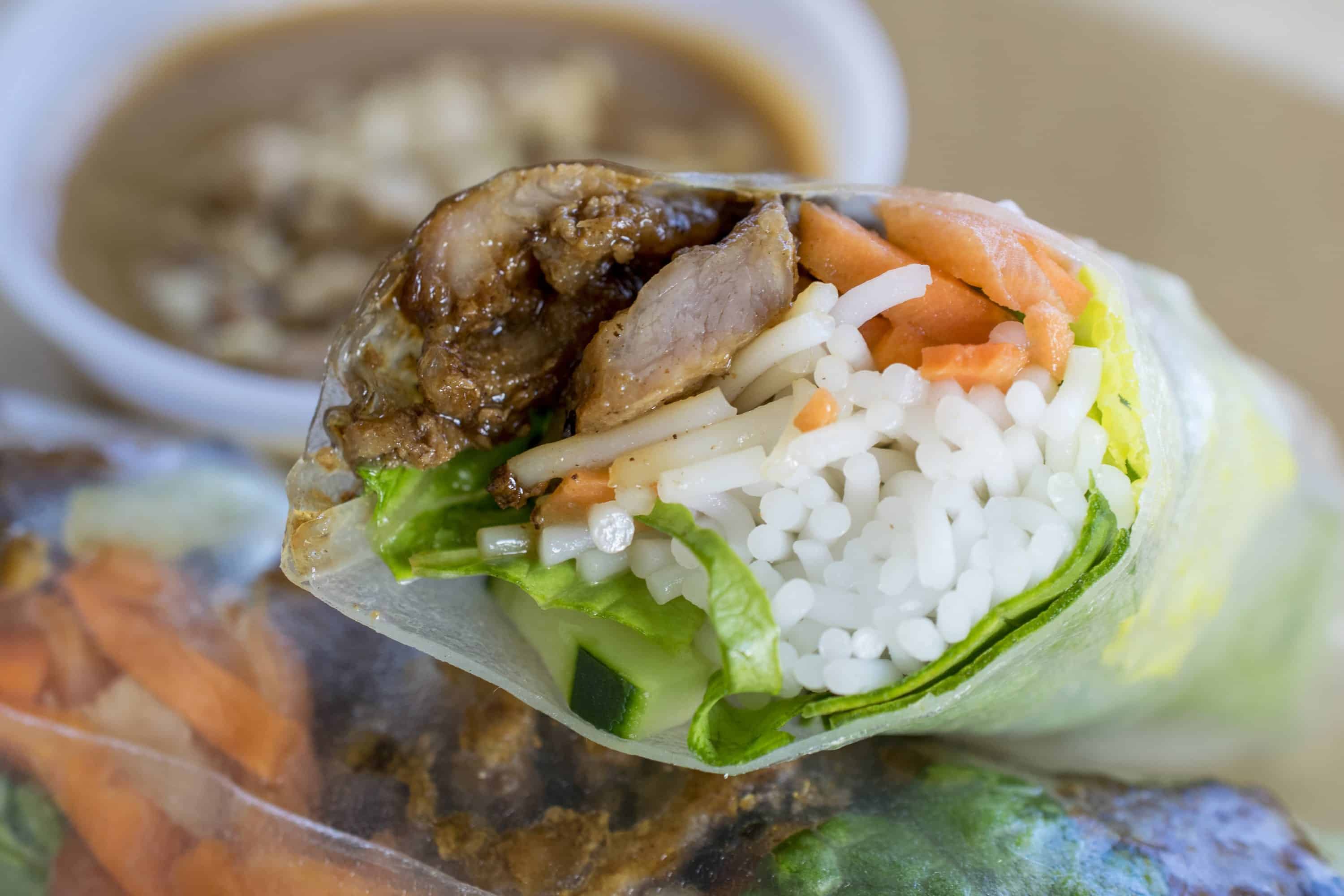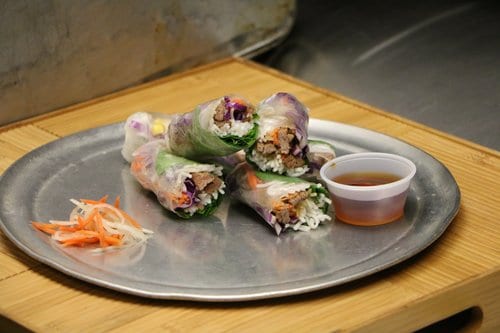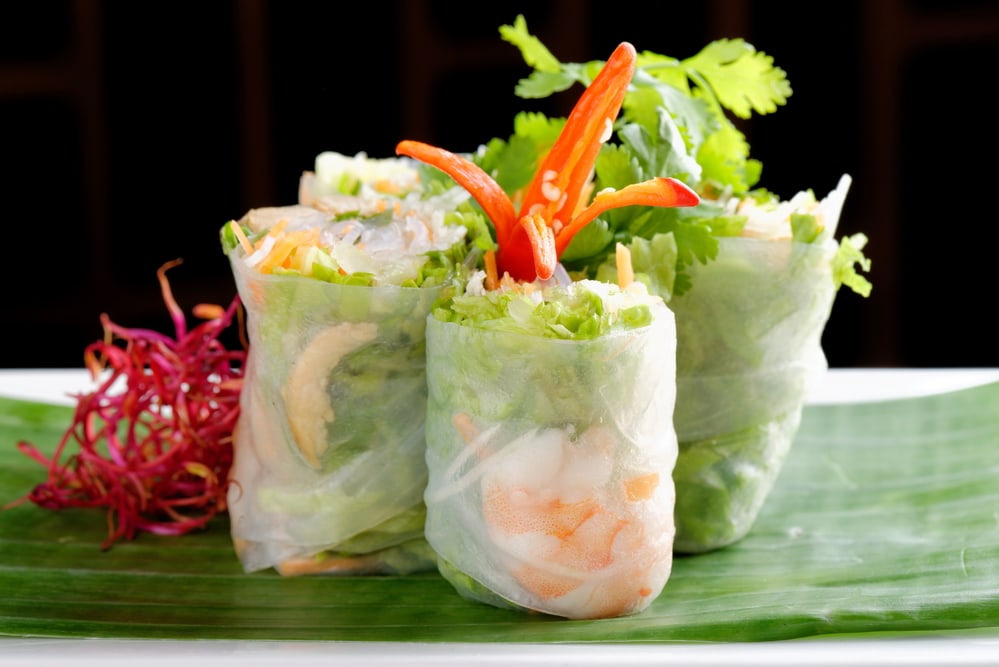A Guide to Vietnamese Spring Roll: Includes Simple Recipe and Cooking Tips
Vietnamese spring roll is a refreshing change from the usual crunchy, fried spring roll variety and has become a people’s favorite. They are a great appetizer and are deliciously dipped in a variety of sauces.
This versatile and healthy snack serves as a healthy and simple meal any time of the day. With a nice crunch from fresh vegetables and savoriness from the meat, spring rolls pack a punch.
Vietnamese spring rolls have been considered as one of the best street foods in the world, making it a must-try for everyone. In this guide, you’ll discover why the scrumptious spring roll is so popular.
Keep reading to get your very own Vietnamese fried spring roll recipe.
A Guide to Vietnamese Spring Roll
Goi Cuon, commonly known as the Vietnamese spring roll, is a famous traditional dish in Southern Vietnam. Goi Cuon is a typical street food that makes a great snack as it is healthy, delicious, and cheap.
This light, fresh snack is considered one of the best street foods in the world and a must-try for every Vietnamese cuisine lover. They are regarded as appetizers for heavier dishes like Pho or La Vong fried fish.
Vietnamese spring rolls usually contain pork, prawns, vermicelli, and vegetables wrapped into a roll made with rice paper. There are thousands of variations and they can be customized as anyone sees fit.
Spring rolls go by many names: goi cuon, nem cuon, rice paper rolls, Vietnamese egg rolls, summer rolls, and fresh rolls.
The goi cuon is known for its transparent wrap, where you can see almost every ingredient used inside. However, the art of wrapping this roll was invented by the Chinese. So, how was Vietnam able to adopt this style of preparing food?
Origin of Goi Cuon
The Vietnamese spring rolls are said to have come from mainland China. The term spring roll came from the Chinese tradition of using ingredients usually harvested during the spring season and wrapping them into a thin pastry.

These spring rolls were traditionally served during the Spring Festival, commonly called Chinese New Year. This festival is celebrated to respect their ancestors and give thanks to their deities for a bountiful harvest.
Spring rolls came to Vietnam after the Chinese immigrants cooked and offered them to their Vietnamese neighbors. The Vietnamese spring roll recipe we know today was modified to be able to use ingredients found in Vietnam to suit people’s tastes.
Goi cuon means salad rolls. However, instead of being mixed in a bowl, the ingredients are wrapped in rice paper to make them more portable. Vietnamese spring roll is widely preferred for its making method which replaces oily processed ingredients with fresh ingredients and boiled meat to retain its natural taste.
Easy Vietnamese Spring Roll Recipe
There are many ways to make spring rolls but let’s discuss what you need for a traditional Vietnamese fried spring rolls recipe:
- Rice paper wrapper
- Thin rice noodles
- Herbs and vegetables
- Meat
- Dipping sauce
Rice paper wrapper: banh trang
Rice paper, also known as banh trang in Vietnamese, is an edible spring roll wrapper made from rice (and sometimes tapioca) flour. To provide a stronghold for the ingredients inside, rice papers used for goi cuon are usually thick.
We like using circular rice paper (22cm) for making Vietnamese spring rolls. They are sold dehydrated. Before rolling, rice papers are quickly soaked in water so they become softer and more pliable.
They come in different sizes: curricular, triangle, square, and half circles. We recommend keeping them in the package and only taking them when needed because they curl when exposed to air. These rice paper sheets can be directly eaten and they have a hint of salt aftertaste.
Thin rice noodles
Typically, a Vietnamese spring roll is made with rice vermicelli, which is thin rice noodles or rice sticks. Their sheets of noodles can be paired with grilled meat. They come dried in rectangular sheets and you can boil them like other rice noodles or pasta.
Pro-tip – Instead of regular rice noodles, use banh hoi. Banh hoi is less sticky and way easier to move around, trim, and arrange in your spring rolls.
Herbs and vegetables
Vegetables are essential for the Vietnamese spring roll recipe. The most common herbs and vegetables used for spring rolls are green leaf lettuce, mint, cilantro, or basil. You can go for any soft, leafy green lettuce as long as they are fresh.
We like a combination of carrots, cucumber, bell pepper, and sliced avocado. The sky’s the limit in terms of the ingredients used in a Vietnamese spring roll. Make sure to slice the vegetables thinly to make them easier to chew!
You might discover a traditional Vietnamese spring roll recipe that uses lettuce leaves because they help make the rolling process easier. When you wrap the noodles, vegetables, and herbs inside the lettuce leaves, the filling won’t spread out everywhere as you roll up with spring rolls.
Meat
The most traditional meat filling for the Vietnamese fried spring roll recipe is pork and shrimp. Use fattier, better-tasting pork and medium-sized shrimp for easier wrapping. Vegetarians can also find a way to tweak this with tofu or mushroom.
The best thing to do for protein is to marinate and fry it. Lots of spring rolls just boil and pan-fry protein, but the best way to experience the flavor is to marinate the protein before cooking it.
Dipping sauce
The most common spring roll sauce is peanut sauce. Tuong Dau Phong is a peanut sauce for spring rolls and is a mixture of peanut butter and fermented soybeans.
Fermented beans are blended into a smooth paste, seasoned, and cooked with peanut butter at a low temperature until it becomes thicker.
When serving spring rolls, you can top this Vietnamese spring roll dipping sauce with roasted peanuts, pickled carrots, and minced chili. This sauce is vegan-friendly and a common option to start with.
Tips for soaking spring roll wrappers
- You want to soak your rice paper, but don’t overdo it or it will become soggy and disintegrate making it fragile and difficult to roll.
- You don’t need hot boiling water. Use tap water or lukewarm water to prevent it from getting too soft.
- All you need to do is take the sheet out of the rice paper, dip it in, make sure the rice paper is submerged and then take it out and lay it flat. Some like to soak it for 10-15 seconds, but you may need to experiment for the best timing.
- To avoid trouble wrapping up your Vietnamese spring roll, use paper with tapioca rather than 100% rice.

How to Cook & Prepare the Perfect Vietnamese Spring Rolls
Vietnamese spring roll ingredients
- 8 rice wrappers
- 2 ounces rice vermicelli
- 8 large cooked shrimp
- 2 leaves lettuce, chopped
- 3 tablespoons chopped mint leaves
- 3 tablespoons chopped fresh cilantro
- 1½ tablespoons fresh Thai basil
Vietnamese fried spring roll recipe & directions
Step one
Fill a pot with lightly salted water and bring to a boil. Add your vermicelli pasta and allow it to boil. Cook it uncovered, and stir occasionally until the paste is firm, usually 3-5 minutes.
Step two
Fill a large bowl with warm water and dip one wrapper into the water for 2 seconds to soften. Lay the wrapper flat; place 2 shrimp halves in the center, and add some vermicelli, mint, lettuce, cilantro, and basil, leaving about 2 inches from each side uncovered.
Fold the uncovered sides inward, then tightly roll the wrapper, beginning at the end with the lettuce. Repeat the same for other ingredients.
Step three
Gently pull the bottom of the wrapper up and over the lower portion of the filling. Try and keep the filling intact as you roll upward, just until they are enveloped. This step may take some practice. The more you do it, the better they will look.
Step four
Serve the Vietnamese spring roll and hoisin sauce mixtures.
Pro-Tip – Rolling a spring roll is similar to rolling a burrito so if you’ve done that before, you’re going to roll it well. You can follow this simple pattern for your Vietnamese spring roll recipe to roll perfectly: dip, arrange, fold, roll.
How to easily devein shrimp
Here’s an easy way to remove that shrimp vein/digestive tract when making shrimp spring roll:
- Defrost your shrimp by soaking it in warm water.
- Grab a toothpick and hold the shrimp in a light source to locate the vein.
- Locate the joint of the shrimp shell (usually lighter in color than the rest of the body).
- Move the toothpick a little below the vein and push the toothpick all the way through the shrimp.
- Gently lift the toothpick outward towards the back of the shrimp, so it breaks through the shell. Do this slowly so the vein stays intact. Then, you’ll see the vein pull out.
- Clean the toothpick and repeat the process.
Pro-tip – Sometimes you may miss and nothing comes out or the vein breaks. That’s fine! Just find another spot to repeat until the shrimp is clear of veins.
Sauces You can Try with Spring Rolls
After trying out the Vietnamese spring roll recipe, what dipping sauce blends perfectly with it? Here’s what you can dip your spring roll in:
Fish sauce
This is one of the most common types of Vietnamese spring roll dipping sauce. It is sour, sweet, salty, and full of rich flavors.
In a bowl or measuring cup, crush together 1 garlic clove, 1 Thai chili (optional), and 1-3 tablespoons of sugar. Stir in 1 cup water, ½ lime juice, and 2 tbsp fish sauce. Mix until the sugar dissolves completely.
Hoisin sauce
You can keep it simple and serve your spring roll with hoisin amped up with lime, garlic, and sugar.
For this sauce: mix together water, ½ juice of lime, 1 tbsp sugar, fish sauce, 1 clove minced garlic, and ¼ cup hoisin sauce in a small bowl until well combined.
Peanut sauce
This creamy and nutty sauce can be made with peanut butter.
In a pan of medium heat, saute garlic in oil. Then, mix together 2 tbsp hoisin sauce, 1 tbsp peanut butter, 1 tbsp lime juice, and 1-2 tbsp water. Bring to a boil and immediately turn off the heat. Pour into a dipping sauce and allow the sauce to thicken.
How to eat Vietnamese spring roll
In Vietnam, the chef typically puts all the ingredients in traditional baskets and assemble them right in front of you. Spring rolls are ordered by number, so if it is your first time, start with two rolls to see how you find them. Don’t forget to request the sauce you prefer. When you get them, simply dip them in the sauce and enjoy.
Char’d Kitchen makes the best Vietnamese spring rolls in Texas. You can find us at three distinct locations in the DFW area: Richardson, Fort Worth, and Mansfield.
Whether you’re a lover of Asian cuisine or you’re trying it out for the first time, you are in for a fantastic dining experience.
If you’d like to order our famous spring rolls or other dishes from the comfort of your home, we have partnered with DoorDash, Uber eats, and Zing My Order to ensure fast delivery to your home, office, or anywhere.

